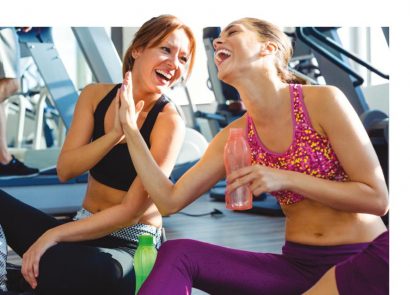In today’s fast-paced, results-driven society, short, sharp high intensity workouts reign supreme. It seems that the allure of an all-out 20-minute interval session beats an hour-long aerobic class every time. Not at all surprising considering that HIIT promises a greater, faster payoff on top of its short completion time. But what if lying half-dead in a pool of sweat just isn’t your cup of tea? Well that, my friends, is where LISS comes in…
“LISS or Low Intensity Steady State is basically any cardio or aerobic based activity that is performed at a low intensity for an extended period of time,” says Michael Duncan, personal trainer at Hall Training Systems. Just think of it as HIIT’s less intimidating cousin! Instead of attacking the treadmill, go for a brisk walk. Tired of racing the woman in the lane next you at the pool? Gracefully fall back and swim it at your own (casual) pace.
Easy does it
Now you might be mistaken for thinking that LISS is merely an excuse to slack off on your usual training. But that’s simply not the case. While it’s true that high intensity exercise burns more calories per minute, the simple fact of the matter is that you can’t physically do it for a prolonged period of time. “Plus HIIT hurts – a lot – and it’s supposed to if you’re doing it properly,” says Michael. “That’s what makes it so effective, but also incredibly hard to recover from.” So whereas intense workouts will often need to be supplemented with rest days, you’ll find that LISS training can be performed daily with little to no down time. And I’m sure we don’t need to remind you that more days spent training equals better results all round!
Burn baby burn
Then there’s its advanced fat burning capabilities to consider. During exercise our bodies rely on either glucose or body fat to provide energy. Of course, it goes without saying that most of us would prefer to use up the latter, but this is rarely the case when engaging in medium-to high intensity workouts. When you’re running or sprinting (as opposed to swiftly walking) your muscles require more oxygen. Your body responds to this need by deepening and quickening the breath, as well as upping your heart rate. This is in order to efficiently pump enough oxygen to the relevant muscle groups. However, this means that there is less of it available for other bodily functions. Namely the metabolism of fat which (rather annoyingly for us) requires far more of the vital element than the breakdown of glucose.
Low intensity training, on the other hand, keep your heart and breath rate steady. This means your body can consistently burn fat throughout the duration of your session. The icing on the cake? “Over time, LISS will condition your body to use more fat as a fuel source even after the workout’s said and done, and that’s no bad thing when your goal is to get rid of the stuff,” explains Michael.
Body and mind
As well as helping with physical helath, Michael notes that LISS cardio also helps us emotionally. Some exercises see physcial and mental health improvements go hand-in-hand (hello, nature hikes!). It also brings about some bonus extras that you won’t get from any other form of training. “It helps to develop adaptations like increases in cardiac output, capillary density and venous return,” he says – essentially a stronger heart, enhanced endurance, better blood flow and more efficient muscles.
Try for size
If you’re new to exercise and fitness, or you’re just getting back into the swing of things after a long break, LISS can be a great starting point. “Low intensity workouts are generally less daunting and a good way to prepare your joints and muscles before jumping into high intensity exercise,” says Michael. Plus you’re more likely to stick with your new routine if you can actually complete it. Even more so if you pick an activity that you enjoy.
But it’s not just newbies who should utilise this unique training method. “LISS also plays an important role in developing aerobic capacity and local muscular endurance, so, if your goal is to do a long distance event, it should always be an essential part of your training plan,” Michael tells us.
So how do you go about incorporating LISS into your fitness regime, I hear you ask? “Well, there’s no need to over complicate things,” says Michael. “The key is to choose something you love doing.” Here at YF HQ, we’re particularly fond of cycling, stand-up paddle boarding and rowing. Many PTs will also recommend that you alternate between your favourite LISS workouts to keep things interesting. Michael suggests working your way up to around three 60-minute sessions a week.
You can also add LISS cardio to a weight-training program – just don’t go overboard! Michael advises keeping your cardio and your resistance sessions separate and choosing the mode wisely. “Light jogging, with its impact element, can affect strength and muscle definition especially as the amount you do increases, whereas cycling due to its minimal impact – and hence its minimal addition to training stress – doesn’t.” So there you have it – an effective fat-blasting workout that requires minimal effort and maximum fun!
Don’t say we never spoil you!




















